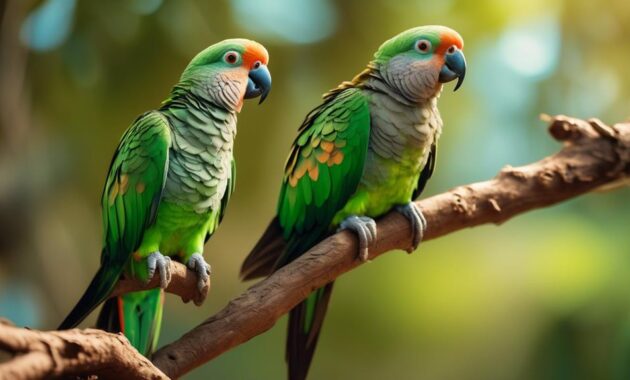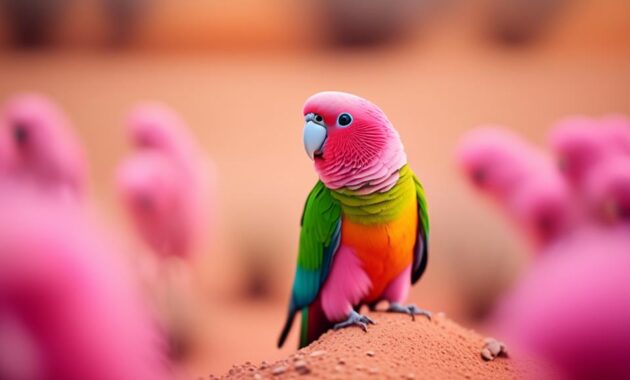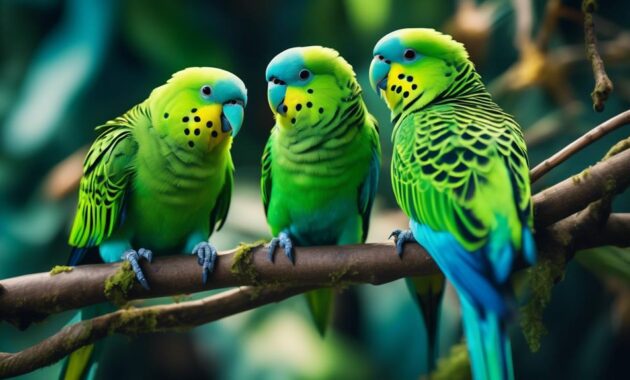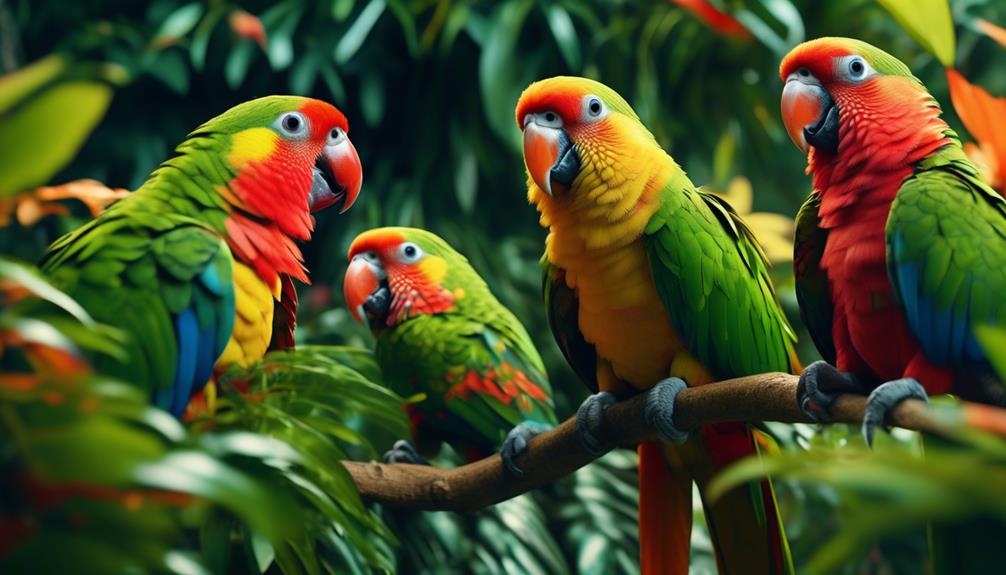
Are you familiar with the vibrant world of Kakariki Parrots? These colorful creatures are not only talkative but also thriving in their natural habitat.
From their distinct features to their incredible vocal abilities, there's so much to explore and learn about these captivating birds. But what sets them apart from other parrots? And how do they manage to thrive despite the challenges they face?
Let's delve into the fascinating world of Kakariki Parrots and discover the secrets behind their vibrant personalities and their ability to thrive in the wild.
Key Takeaways
- Kakariki Parrots are nimble and attractive parrots native to New Zealand.
- They have a mostly green body with blue primary flight feathers and distinctive facial markings.
- Kakariki Parrots have impressive vocal abilities, can mimic sounds, and even learn new words.
- Conservation efforts have helped protect Kakariki Parrots from habitat loss and hunting, focusing on controlling predators and restoring their natural habitats.
Description and Characteristics
Kakariki Parrots are nimble and attractive parrots known for their distinctive features and vibrant colors. These parrots have an average length of 11 inches and weigh up to 4 ounces. They've a chubby body and a unique face, with females being slightly smaller.
Kakariki Parrots are robust and hardy birds, with strong beaks that they use for various activities. They're native to New Zealand and can be found in open areas, scrubland, grasslands, and forests. Although they once suffered from habitat loss and hunting, they're now a protected species with rising numbers.
Kakariki Parrots are also known for their vocal abilities. They produce cute sounds, mimicry, and can even learn to talk. Their vibrant colors include a mostly green body, blue primary flight feathers, a bright red patch on the forehead, and a red circle on the cheeks. The yellow mutation is a popular variant, and these parrots are available in several different color combinations.
Habitat and Conservation
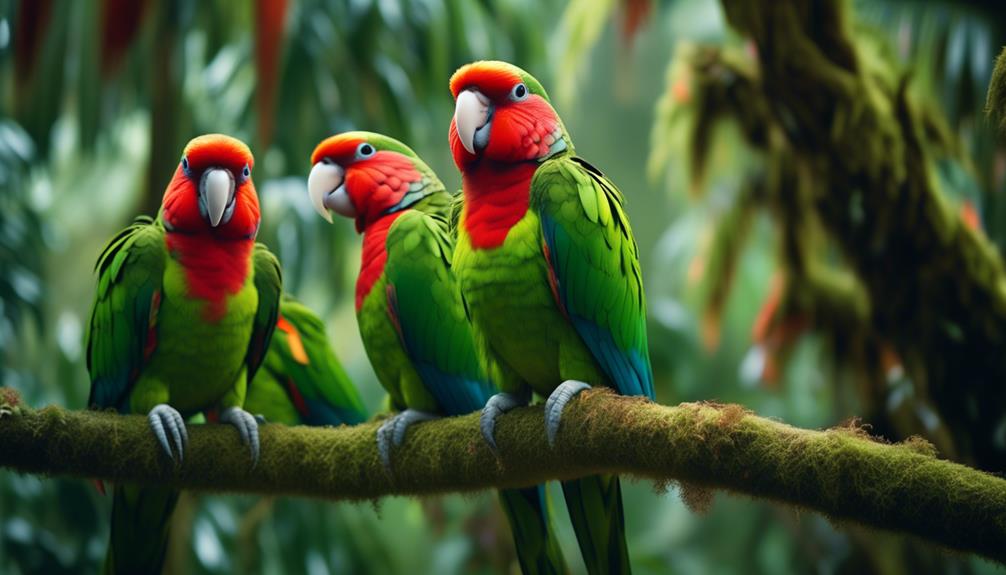
As we turn our attention to the habitat and conservation of these vibrant and talkative parrots, it's important to understand the natural environment in which Kakariki Parrots thrive. Native to New Zealand, Kakariki Parrots are found in open areas, scrubland, grasslands, and forests. Although they once suffered from habitat loss and hunting, they're now a protected species with rising numbers.
The main threats they face are rats and possums, which can disrupt their nesting sites and prey on their eggs and chicks. Efforts are being made to control these predators and restore their habitat. Conservation initiatives focus on creating safe spaces for these parrots to breed and ensuring their natural habitats are protected.
Sounds and Speech
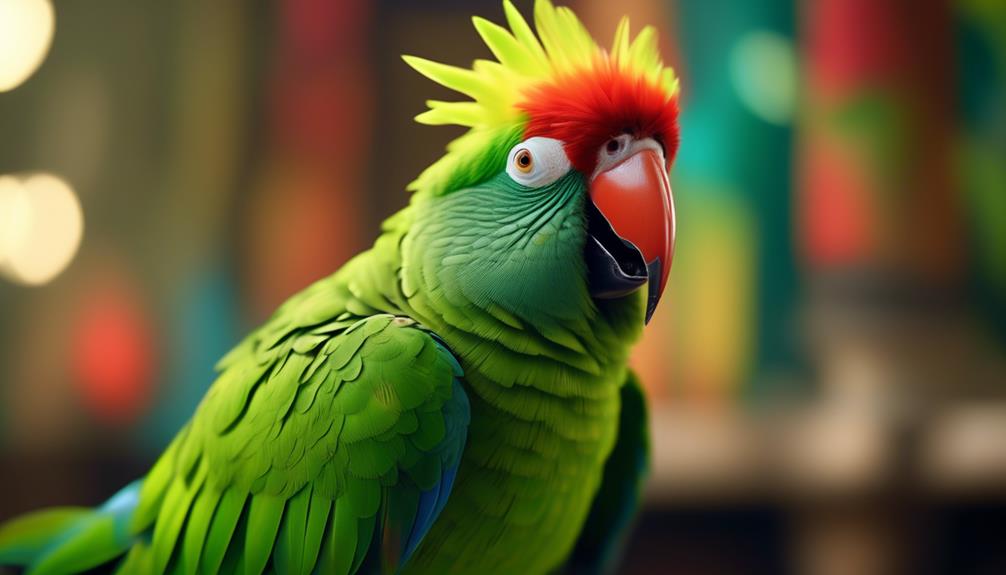
When it comes to the Kakariki Parrot's sounds and speech, you'll be amazed by their vocal abilities. These parrots are quick learners and can produce cute sounds, mimicry, and even learn new words. They've the ability to chatter softly and mumble to themselves, creating goofy conversations that melt your heart.
Their vocal range is truly impressive, and their ability to imitate different sounds is remarkable. Whether it's mimicking the sound of a doorbell or a ringing phone, these parrots will leave you speechless.
Not only are they talkative, but they also have a knack for expressing their emotions through their vocalizations. From joyful chirping to low murmurs, the Kakariki Parrots are truly a delight to listen to.
Colors
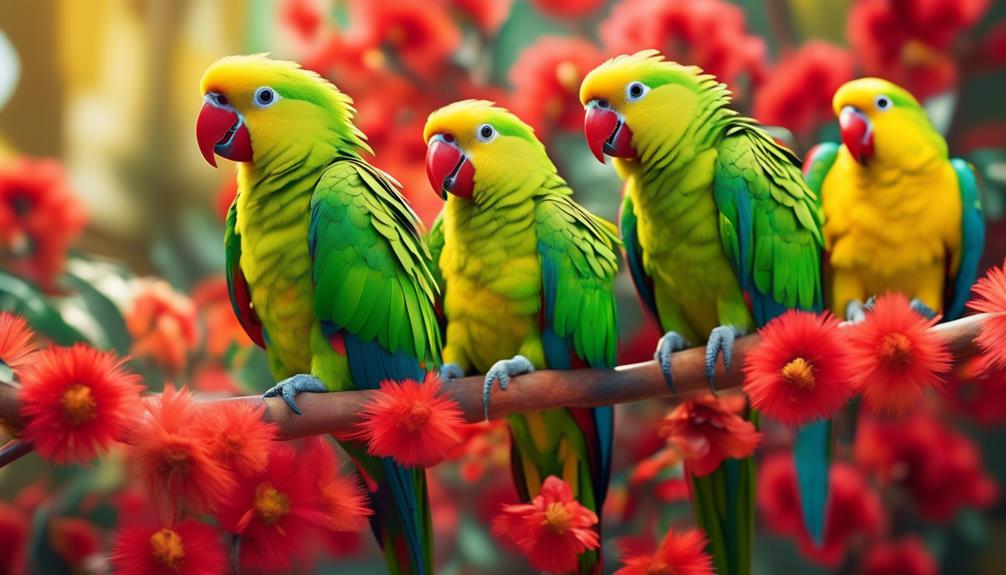
The vibrant colors of the Kakariki Parrots are truly a sight to behold. These beautiful birds have a mostly green body with lighter tones on the chest, which adds a touch of elegance to their appearance.
Their wings are adorned with stunning blue primary flight feathers, creating a striking contrast against the green plumage. One of their most distinctive features is the bright red patch on their forehead and the red circle on their cheeks, adding a pop of color to their already vibrant look.
Additionally, there's a popular yellow mutation variant, which further enhances their beauty. Kakariki Parrots are available in several different color combinations, making each individual bird a unique and captivating sight.
Variants and Mutations
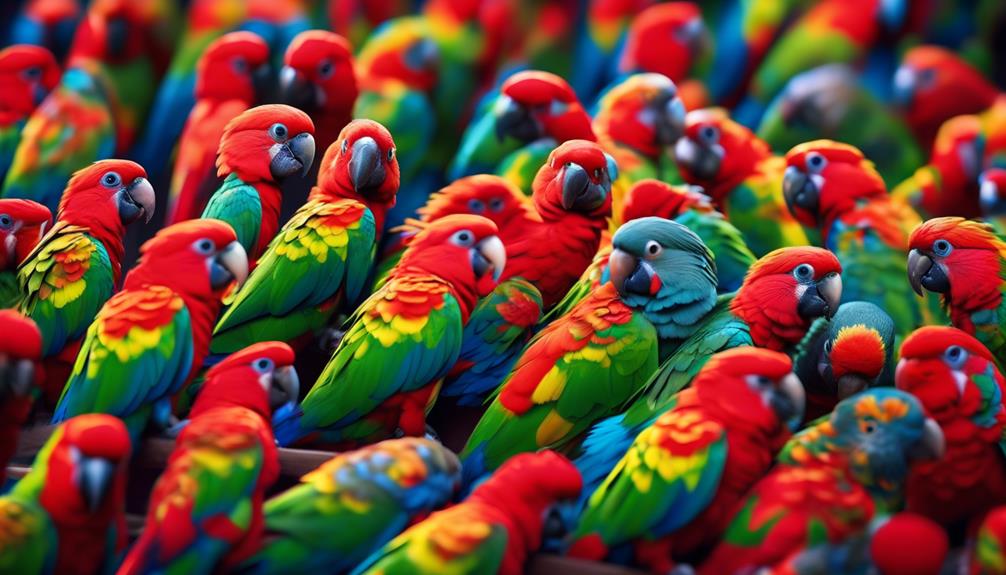
Moving on to the topic of 'Variants and Mutations', let's explore the fascinating range of colors that Kakariki Parrots can display. These vibrant birds not only come in the classic green color, but they also have different color combinations due to mutations. One popular variant is the Yellow mutation, which results in a stunning yellow body with hints of green. Another mutation is the Cinnamon, which gives the parrot a warm brownish tone. Lastly, there is the Yellow-green mutation, which combines yellow and green hues for a unique and eye-catching appearance. To give you a clearer picture, here is a table showcasing the different color variants and mutations of Kakariki Parrots:
| Variants and Mutations |
|---|
| Green |
| Yellow |
| Cinnamon |
| Yellow-green |
With these variants and mutations, Kakariki Parrots truly stand out as beautiful and diverse creatures.
Diet and Feeding
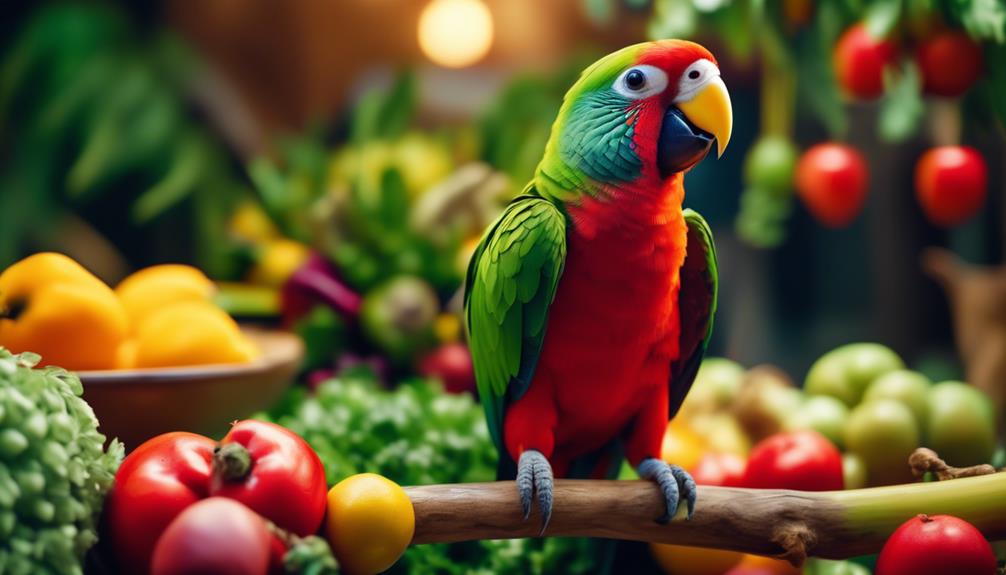
To ensure the health and well-being of your Kakariki Parrot, it's important to provide them with a balanced and nutritious diet.
These vibrant and talkative parrots require a variety of foods to meet their dietary needs. The foundation of their diet should be a high-quality pellet or seed mix specifically formulated for parrots.
Additionally, they should be offered a wide range of fresh fruits and vegetables, such as apples, carrots, leafy greens, and berries. It's essential to avoid feeding them avocados, chocolate, caffeine, and any other toxic foods.
Kakariki Parrots also enjoy treats like nuts and seeds in moderation. Fresh water should be available at all times. Remember to monitor their food intake and adjust accordingly to maintain a healthy weight.
Breeding and Reproduction
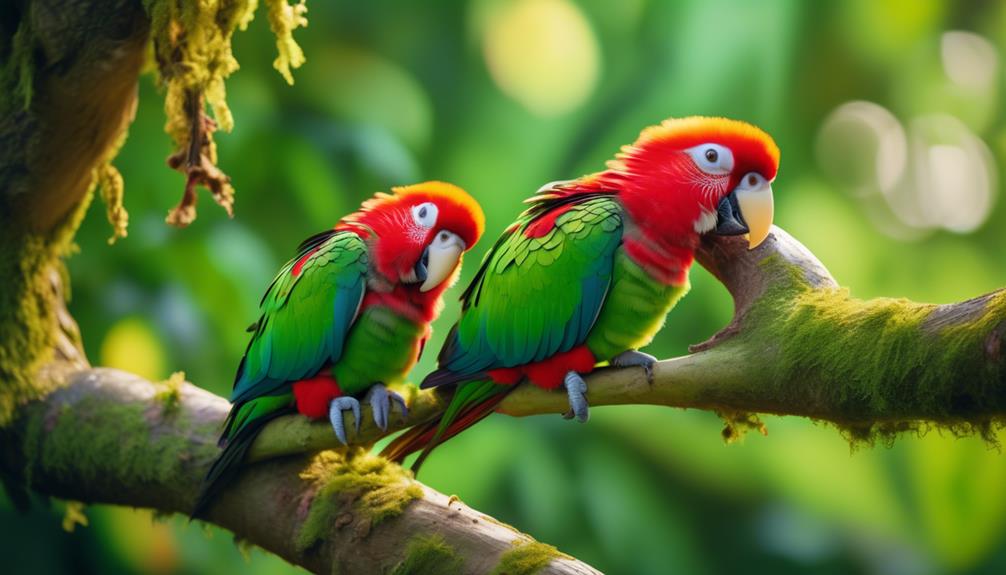
As you continue to explore the fascinating world of Kakariki Parrots, let's now turn our attention to their breeding and reproduction behaviors.
Kakariki parrots are known to be excellent breeders, and they reach sexual maturity at around 1 year of age. Breeding pairs will usually mate for life and exhibit strong bonds. They're cavity nesters, preferring holes in trees or nest boxes for breeding.
The female will lay a clutch of 4-8 eggs, which both parents take turns incubating for about 21 days. Once the chicks hatch, both parents actively participate in feeding and caring for them.
The young birds fledge at around 6-7 weeks of age, but they'll still rely on their parents for food and protection for a few more weeks.
Training and Enrichment
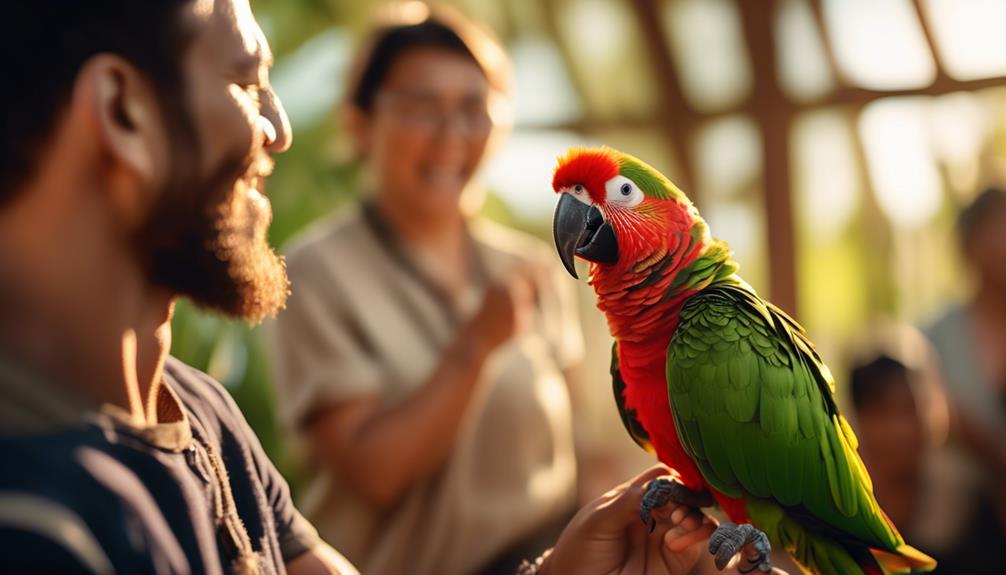
Get ready to unlock the full potential of your Kakariki Parrot with effective training and enriching activities.
These vibrant and talkative parrots thrive when provided with mental stimulation and physical exercise.
Training your Kakariki Parrot can be a rewarding experience, as they're quick learners and can be taught various tricks and commands.
Start by establishing a strong bond with your parrot through positive reinforcement techniques, such as offering treats and praise.
Use clicker training to teach them specific behaviors, and gradually increase the difficulty level as they progress.
Enrichment activities, such as providing puzzle toys, foraging opportunities, and a variety of perches, will keep your Kakariki Parrot mentally engaged and entertained.
Remember to always prioritize their safety and well-being during training sessions and enrichment activities.
Health and Care
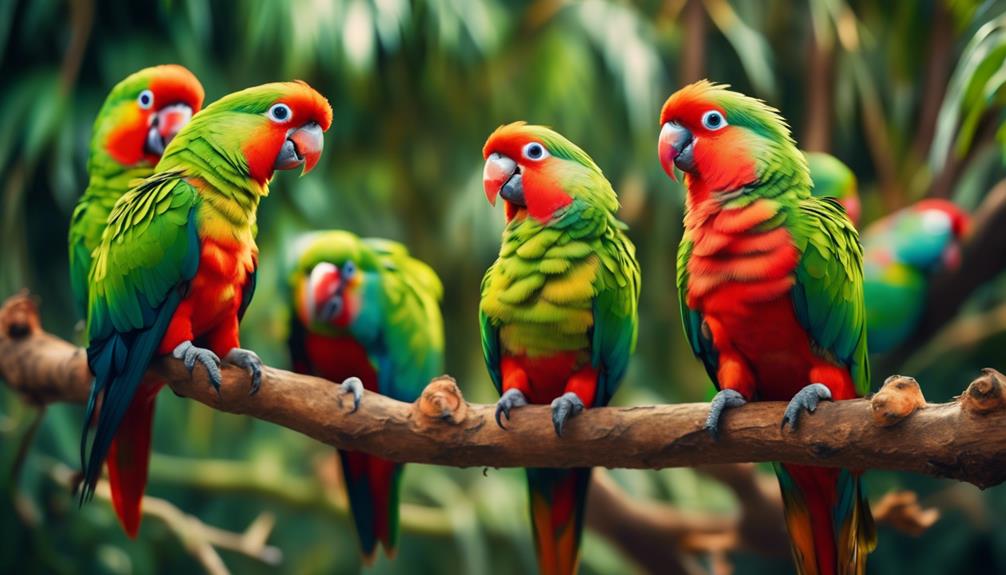
Now that you've established a strong bond with your Kakariki Parrot through training and enrichment, it's important to focus on their health and care. Taking care of your parrot's health involves providing a balanced diet, regular exercise, and routine veterinary check-ups. Here's a table to help you understand the key aspects of their health and care:
| Aspects of Health and Care | Importance |
|---|---|
| Balanced Diet | Essential |
| Regular Exercise | Vital |
| Veterinary Check-ups | Crucial |
| Mental Stimulation | Important |
Frequently Asked Questions
What Is the Average Lifespan of a Kakariki Parrot?
The average lifespan of a kakariki parrot is 10-15 years. These vibrant and talkative birds are thriving. They are known for their cute sounds, mimicry, and talking abilities that will leave you speechless.
How Can I Help Protect the Kakariki Parrot's Habitat From Rats and Possums?
To protect the kakariki parrot's habitat from rats and possums, you can set up traps or use bait stations. Make sure to regularly monitor and maintain them. Your efforts will help ensure their thriving population.
Can Kakariki Parrots Talk and Mimic Sounds?
Yes, Kakariki Parrots can talk and mimic sounds. Their vocal abilities will leave you speechless! They are quick learners and can even learn new words. Get ready for goofy conversations that will melt your heart.
Are Kakariki Parrots Good Pets for Beginners?
Yes, Kakariki parrots are good pets for beginners. They are hardy, easy to care for, and have a playful personality. With their vibrant colors and talkative nature, they will bring joy to your home.
What Are the Most Popular Color Mutations of Kakariki Parrots?
The most popular color mutations of Kakariki Parrots are the green, yellow, cinnamon, and yellow-green variations. These vibrant and talkative birds come in a range of beautiful colors that are sure to captivate you.
What Makes Kakariki Parrots Thrive and How Do They Compare to Masked Lovebirds?
Kakariki parrots thrive in diverse habitats, while masked lovebirds prefer arid regions. Kakarikis are skilled climbers and love to play, while masked lovebirds are excellent flyers and vocal communicators. Fascinating facts about masked lovebirds include their strong pair bonds and affectionate nature towards their mates.
Conclusion
In conclusion, Kakariki Parrots are truly remarkable creatures with their vibrant colors, talkative nature, and thriving population.
Native to New Zealand, these resilient birds have overcome habitat loss and hunting to become a protected species.
Their vocal abilities and cute sounds make them even more endearing. With their distinct features and unique mutations, Kakariki Parrots are a sight to behold.
Taking care of their diet, breeding, and providing enrichment are essential for their health and well-being.
These playful and intelligent birds bring joy and beauty to their natural habitat.


